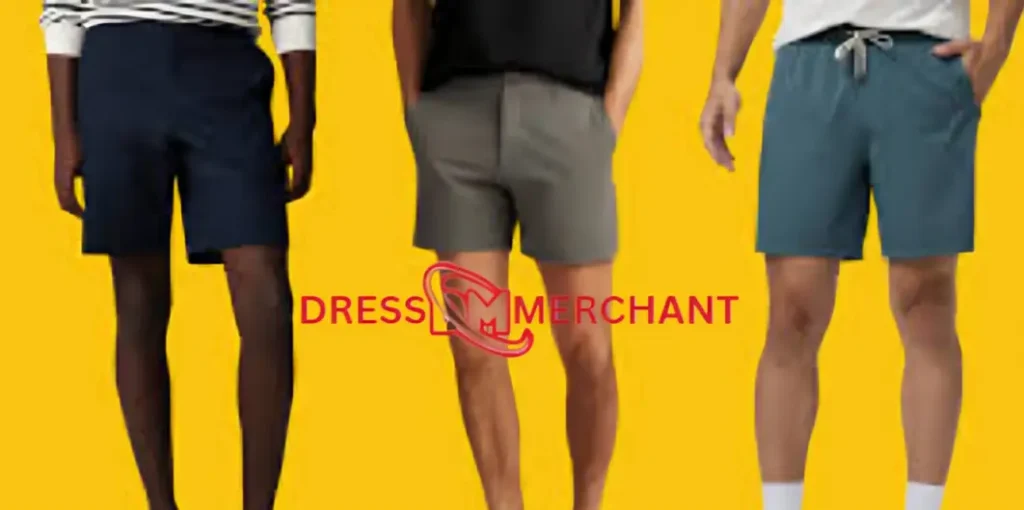Breathable Shorts For Hot Weather are a must-have for comfort and style in extreme heat. Dress Merchant, a trusted apparel sourcing agent, connects global buyers with premium manufacturers and exporters of high-quality breathable shorts. Our expert sourcing solutions ensure access to lightweight, sweat-wicking fabrics ideal for summer wear. Choose Dress Merchant for reliable, efficient, and cost-effective garment sourcing tailored to your brand’s needs.
Thank you for reading this post, don't forget to subscribe!
1. The Science of Staying Cool: How Breathable Fabrics Work
Understanding why certain fabrics feel cool while others trap heat is fundamental to appreciating the value of breathable shorts. It’s not just about a feeling; it’s about thermodynamics and moisture management. When your body heats up, it naturally tries to cool down through perspiration. This sweat then evaporates from your skin, taking heat with it – a process known as evaporative cooling.
Breathable fabrics are designed to facilitate this process, allowing air to circulate freely and moisture to escape efficiently. Without this crucial airflow and moisture wicking, sweat remains trapped against your skin, leading to that sticky, uncomfortable, and often irritating sensation.
1.1 Understanding Fabric Weave and Porosity
The fundamental characteristic contributing to a fabric’s breathability is its weave and resulting porosity. Think of it like a mesh. Loosely woven fabrics, with more space between the individual threads, inherently allow for greater airflow. This isn’t just about the type of fiber used, but how those fibers are constructed into a textile. A tightly woven denim, for example, will feel significantly hotter than a loosely woven linen, even if both are made from natural fibers.
The size and consistency of the pores within the fabric directly impact how easily air can pass through, carrying away heat and moisture. Manufacturers employ various weaving techniques, such as plain weaves, leno weaves, or open knits, specifically to enhance this porosity, creating a microclimate around your skin that promotes cooling.
1.2 The Role of Moisture-Wicking Properties
Beyond simply allowing air to pass through, truly breathable fabrics excel at managing moisture. This is where moisture-wicking properties come into play. Wicking refers to a fabric’s ability to draw moisture (sweat) away from your skin and transfer it to the fabric’s outer surface, where it can evaporate more readily. This is often achieved through capillary action, where tiny spaces within the fabric act like microscopic straws, pulling moisture along.
Natural fibers like cotton and linen have some inherent wicking capabilities, but synthetic fibers like polyester and nylon are often engineered with specific cross-sections and surface treatments to significantly enhance this property. This rapid transfer of moisture keeps your skin feeling drier and prevents the clammy sensation that can lead to chafing and discomfort in hot, humid conditions.
1.3 Thermal Regulation and Air Permeability
Thermal regulation is the body’s ability to maintain its core temperature within a narrow range, regardless of external conditions. Breathable fabrics assist in this process by promoting air permeability. Air permeability is a measure of how easily air can pass through a fabric. High air permeability allows for a constant exchange of air between your skin and the environment, facilitating the dissipation of body heat through convection.
When warm, moist air near your skin is replaced by cooler, drier air, it creates a refreshing sensation and prevents overheating. This continuous air circulation is paramount for maintaining comfort and preventing heat stress, especially during physical activity or prolonged exposure to high temperatures. The interplay of weave, wicking, and air permeability is what truly defines a fabric’s ability to keep you cool.
2. Why Breathable Shorts are Essential for Hot Climates
Living in or traveling to a hot climate presents a unique set of challenges, and your clothing choices can significantly impact your comfort and well-being. Breathable shorts aren’t just a fashion choice; they are a practical necessity, offering a multitude of benefits that extend far beyond simple comfort. From preventing heat-related issues to enhancing mobility and overall enjoyment, their importance cannot be overstated.
2.1 Preventing Overheating and Heat-Related Illnesses
One of the most critical reasons to opt for breathable shorts in hot weather is their role in preventing overheating. When your body struggles to dissipate heat, your core temperature can rise to dangerous levels, leading to heat exhaustion or even heatstroke.
Symptoms can range from dizziness and nausea to confusion and loss of consciousness. Breathable shorts, by facilitating efficient sweat evaporation and air circulation, help your body regulate its temperature more effectively, significantly reducing the risk of these serious conditions. They allow your natural cooling mechanisms to function optimally, providing a crucial line of defense against the relentless summer heat.
2.2 Minimizing Chafing and Skin Irritation
Hot weather combined with restrictive or non-breathable fabrics can lead to a host of uncomfortable skin issues, with chafing being one of the most common. When sweat is trapped against the skin and friction occurs, it can cause redness, rawness, and painful irritation, particularly in areas like the inner thighs.
Breathable shorts, by keeping the skin drier and allowing for better airflow, dramatically reduce the likelihood of chafing. The enhanced ventilation prevents moisture buildup, minimizing the conditions that contribute to skin friction and irritation, allowing you to move freely and comfortably throughout the day without discomfort.
2.3 Enhancing Comfort During Physical Activity
Whether you’re going for a leisurely stroll, a vigorous hike, or simply running errands, hot weather can make any physical activity feel more taxing. Breathable shorts are a game-changer for active individuals. Their lightweight nature and ability to manage moisture prevent that heavy, damp feeling that can weigh you down. The increased airflow keeps your muscles cooler, which can help prevent premature fatigue and improve your overall performance.
Furthermore, many breathable shorts are designed with ergonomic cuts and stretchy fabrics that allow for a full range of motion, ensuring that your clothing never hinders your movements, even during the most demanding summer activities.
3. Top Fabric Choices for Optimal Breathability
The material composition of your shorts is the single most important factor determining their breathability. Not all fabrics are created equal when it comes to keeping you cool. Understanding the properties of different fibers and blends will empower you to make informed decisions and select shorts that genuinely deliver on their promise of superior comfort in the heat.
3.1 Lightweight Cotton: The Classic and Versatile Option
Cotton has long been a go-to fabric for warm weather, and for good reason. Its natural fibers are soft, absorbent, and, in lightweight weaves, offer decent breathability. Cotton allows air to circulate, and its absorbency helps wick away sweat. However, it’s important to distinguish between different types of cotton. A heavy denim or thick twill cotton will trap heat, while a light voile, seersucker, or jersey cotton will be far more breathable.
The key is to look for lighter weights and looser weaves. While cotton absorbs moisture well, it can also hold onto it, making it slow to dry compared to some synthetics. This means it might feel damp for longer during intense activity or in very humid conditions. Despite this, for everyday casual wear in moderate heat, lightweight cotton remains a comfortable and widely available choice.
3.2 Linen: Nature’s Answer to Summer Heat
Linen is arguably the king of natural breathable fabrics for hot weather. Derived from the flax plant, linen fibers are thicker and stronger than cotton, creating a fabric with a naturally looser weave and an open structure. This inherent characteristic allows for exceptional airflow and rapid heat dissipation. Linen is also highly absorbent and dries much faster than cotton, making it an excellent choice for humid environments.
Its characteristic crisp texture and tendency to wrinkle are often seen as part of its charm, contributing to its relaxed, summery aesthetic. For those seeking maximum natural breathability and a sophisticated yet casual look, linen shorts are an unparalleled option. They offer a luxurious feel combined with superior cooling properties.
3.3 Performance Synthetics: Polyester and Nylon Blends
While natural fibers excel in many aspects, performance synthetics like polyester and nylon have been engineered to address specific needs in hot weather, particularly for athletic pursuits. Modern synthetic fabrics are far removed from the clammy, non-breathable polyesters of the past. Today’s high-performance polyester and nylon blends are renowned for their exceptional moisture-wicking capabilities.
They draw sweat away from the skin rapidly and spread it across the fabric surface, where it evaporates quickly, keeping you dry and comfortable. They are also incredibly lightweight, durable, and resistant to wrinkles and shrinking. Many synthetic fabrics incorporate specific weave structures or microfibers to enhance air permeability. While they may not always feel as “natural” as cotton or linen, their superior drying times and moisture management make them ideal for active wear, travel, and situations where rapid drying is crucial.
3.4 Blends for Enhanced Properties
Often, the best solution combines the strengths of different fibers. Fabric blends are increasingly popular for creating shorts that offer a balanced combination of properties. For instance, a cotton-linen blend can provide the softness of cotton with the superior breathability and quick-drying nature of linen. A cotton-polyester blend might offer improved durability, wrinkle resistance, and faster drying than pure cotton, while still retaining some of cotton’s natural feel.
For performance wear, a blend of polyester and spandex (elastane) provides excellent stretch and mobility alongside moisture-wicking and breathability. When choosing shorts, pay attention to the fabric composition; a well-designed blend can often offer a more versatile and comfortable experience than a single-fiber fabric.
4. Style and Design Considerations for Breathable Shorts
Beyond the fabric, the cut, fit, and overall design of your shorts play a significant role in their breathability and comfort. A well-designed pair of breathable shorts considers not only the material but also how the garment interacts with your body and the environment. Choosing the right style can maximize airflow and enhance your overall summer experience.
4.1 Loose Fit vs. Tailored Silhouettes
The fit of your shorts directly impacts airflow. Generally, a looser fit allows for more air circulation around the legs, promoting better heat dissipation. Wide-leg shorts, Bermuda shorts, or relaxed-fit athletic shorts are excellent examples of styles that prioritize airflow. However, “loose” doesn’t have to mean baggy or shapeless. A well-tailored short can still be breathable if it’s not overly restrictive around the thighs and waist. Tailored shorts in breathable fabrics like linen or lightweight cotton can offer a more refined look while still providing adequate ventilation. The key is to avoid anything too tight or constricting, as this will trap heat and moisture, regardless of the fabric’s inherent breathability.
4.2 Waistband and Pocket Design for Airflow
Even seemingly minor details like the waistband and pocket design can affect breathability. A wide, elastic waistband, while comfortable, can sometimes trap heat around the midsection if not designed with ventilation in mind. Look for waistbands that incorporate mesh linings or are made from highly breathable materials. Similarly, bulky or numerous pockets, especially those with heavy flaps or linings, can impede airflow and add unnecessary bulk.
Streamlined pocket designs, such as simple slash pockets or lightweight mesh pockets, are preferable for maximizing breathability. Some performance shorts even feature perforated zones or laser-cut vents in strategic areas, including the waistband, to enhance airflow where it’s needed most.
4.3 Inseam Length and Leg Opening
The inseam length and the width of the leg opening also contribute to breathability. Shorter inseams naturally expose more of the leg to the air, promoting greater cooling. However, personal preference and occasion will dictate the appropriate length. Bermuda shorts offer a good balance of coverage and breathability, while athletic shorts are often shorter for maximum freedom of movement and airflow.
A wider leg opening allows for more air to circulate around the thighs, whereas a very narrow or tapered leg opening can restrict airflow. Consider your activity level and desired aesthetic when choosing inseam length and leg opening, always prioritizing designs that allow for ample ventilation without being overly revealing or impractical.
5. Practical Features for Enhanced Comfort
Beyond the fundamental aspects of fabric and design, several practical features can significantly enhance the comfort and functionality of breathable shorts, especially during extended wear or specific activities in hot weather. These thoughtful additions can make a noticeable difference in your overall experience.
5.1 Quick-Drying Technology
For activities involving sweat, water sports, or unexpected rain showers, quick-drying technology is a game-changer. Fabrics treated with quick-drying properties, often synthetics or blends, are engineered to shed moisture rapidly, meaning your shorts won’t stay damp and clammy for long. This is achieved through specialized fiber structures that minimize water absorption and maximize surface area for evaporation.
Quick-drying shorts are invaluable for travelers who need to wash and re-wear garments frequently, or for athletes who want to avoid the discomfort of soggy clothing after a workout. They prevent the chilling effect that can occur when wet fabric stays against the skin, and significantly reduce the risk of chafing and skin irritation.
5.2 UV Protection (UPF Rating)
In sunny climates, protecting your skin from harmful UV radiation is paramount. Some breathable shorts, particularly those designed for outdoor activities, incorporate UPF (Ultraviolet Protection Factor) ratings. A UPF rating indicates how much UV radiation a fabric blocks. For example, a UPF 30 fabric blocks 96.7% of UV rays, while a UPF 50+ fabric blocks 98% or more.
Choosing shorts with a good UPF rating provides an extra layer of sun protection for your legs, reducing the risk of sunburn and long-term skin damage. This is especially important for extended periods spent outdoors, whether hiking, boating, or simply lounging in the sun. It’s a proactive measure for skin health that doesn’t compromise on breathability.
5.3 Anti-Odor Treatments
Hot weather and sweat can often lead to unpleasant odors. Many modern breathable shorts, especially those made from synthetic performance fabrics, incorporate anti-odor treatments. These treatments work by inhibiting the growth of odor-causing bacteria on the fabric. Common methods include silver-ion technology or antimicrobial finishes.
While these treatments don’t eliminate the need for washing, they can significantly extend the time between washes and keep you feeling fresher for longer. This is particularly beneficial for multi-day trips, camping, or any situation where frequent laundry isn’t an option. Anti-odor properties ensure your shorts remain pleasant to wear even after intense activity in high temperatures.
6. Breathable Shorts for Different Activities and Occasions
The versatility of breathable shorts means there’s a perfect pair for almost every activity and occasion where hot weather is a factor. Matching the right style and features to your specific needs ensures optimal comfort and functionality.
6.1 Casual Everyday Wear and Lounging
For everyday comfort and relaxation, breathable shorts are an absolute must. Think lightweight cotton shorts, soft linen blends, or relaxed-fit jersey shorts. These are perfect for running errands, leisurely walks, backyard barbecues, or simply lounging around the house.
Look for styles with elastic waistbands for maximum comfort and an easy, relaxed fit. Colors and patterns can be more varied here, allowing for personal expression. The focus is on unrestrictive movement and a constant feeling of airy coolness. Pair them with a simple t-shirt, a flowy tank top, or a casual button-down shirt for an effortlessly chic hot weather look.
6.2 Athletic and Outdoor Activities
When it comes to exercise in the heat, breathable shorts are non-negotiable. Performance-focused synthetic shorts with superior moisture-wicking and quick-drying properties are key. For running, look for lightweight shorts with built-in liners to prevent chafing. For hiking, consider durable yet breathable fabrics like ripstop nylon with multiple pockets for essentials.
For water sports, quick-drying board shorts or swim shorts are ideal. Many athletic shorts feature perforated panels, laser-cut ventilation, and four-way stretch fabrics to maximize airflow and freedom of movement. The aim is to minimize sweat buildup, keep you dry, and allow for an unrestricted range of motion, letting you focus on your activity, not your discomfort.
6.3 Travel and Packing Considerations
Breathable shorts are a traveler’s best friend in hot destinations. When packing, look for shorts that are lightweight, wrinkle-resistant, and quick-drying, allowing you to pack less and wash on the go. Versatile styles that can transition from casual sightseeing to a relaxed dinner are invaluable. Linen or linen-blend shorts often fit this bill, offering both comfort and a stylish aesthetic.
Performance synthetic shorts are also excellent for travel due to their durability and rapid drying times. Prioritize shorts that can be easily rolled or folded without taking up much space, and that can withstand multiple wears without needing immediate washing, ensuring you stay cool and fresh throughout your adventures.
6.4 Smart Casual and Dressier Occasions
Breathable shorts don’t have to be exclusively casual. For smart casual or slightly dressier hot weather occasions, opt for tailored shorts in premium breathable fabrics like fine linen, lightweight chino cotton, or even a breathable wool blend. Look for clean lines, well-defined pleats (if applicable), and a slightly longer inseam for a more polished look.
Pair them with a crisp button-down shirt (linen or lightweight cotton are great choices), a polo shirt, or a sophisticated knit top. This allows you to remain cool and comfortable without sacrificing style, making them suitable for garden parties, resort dinners, or warm-weather social events where a more refined appearance is desired.
7. Caring for Your Breathable Shorts
Proper care is essential to maintain the performance and longevity of your breathable shorts. Different fabrics require specific attention, and following care instructions will ensure your shorts continue to keep you cool and comfortable season after season.
7.1 Understanding Fabric-Specific Care Instructions
Always check the care label on your shorts, as instructions can vary significantly based on the fabric composition. Natural fibers like cotton and linen generally tolerate warm water washes but may be prone to shrinking or wrinkling if tumble-dried on high heat. Synthetics, on the other hand, often prefer cooler washes to prevent damage to their performance properties and can typically be line-dried quickly.
Blends will often have care instructions that cater to the most delicate fiber in the mix. Ignoring these instructions can lead to faded colors, damaged elastic, reduced wicking capabilities, or a loss of shape, compromising the very breathability you sought.
7.2 Washing Techniques to Preserve Breathability
To preserve the breathable properties of your shorts, especially those with advanced wicking or anti-odor treatments, it’s generally best to wash them in cool or lukewarm water. Hot water can damage delicate fibers and break down performance finishes. Use a mild detergent and avoid harsh bleach or fabric softeners, as these can clog fabric pores and reduce breathability and wicking effectiveness.
For synthetics, specifically, fabric softeners can leave a residue that impedes moisture transfer. Wash similar colors together and turn shorts inside out to protect any external finishes or prints. A gentle cycle is usually sufficient to clean breathable fabrics without causing undue wear and tear.
7.3 Drying Methods for Longevity and Performance
Air drying is almost always the best method for breathable shorts. Line drying or laying them flat to dry prevents heat damage from tumble dryers, which can degrade elastic, damage performance fibers, and cause shrinking in natural fabrics. Breathable fabrics, especially quick-drying synthetics and linen, will dry remarkably fast when air-dried. If you must use a dryer, opt for the lowest heat setting or an air-fluff cycle.
Remove them while slightly damp to minimize wrinkles and over-drying. Proper drying techniques will ensure your shorts maintain their shape, integrity, and crucial breathable qualities for many summers to come.
8. Accessorizing Your Breathable Shorts
Accessorizing can elevate your breathable shorts from purely functional items to stylish components of your summer wardrobe. The right accessories can complement their casual nature or dress them up, all while keeping the focus on comfort and a relaxed, warm-weather aesthetic.
8.1 Footwear Choices for Complementary Comfort
The shoes you pair with breathable shorts are crucial for maintaining an overall comfortable and cool ensemble. For casual wear, sandals, espadrilles, lightweight canvas sneakers, or boat shoes are ideal. They allow your feet to breathe and contribute to a relaxed summer vibe. For athletic shorts, performance sneakers designed for breathability are a must.
When dressing up tailored breathable shorts, opt for loafers, driving shoes, or even clean, minimalist leather sneakers. Avoid heavy boots or overly structured closed-toe shoes that will trap heat, defeating the purpose of your breathable shorts. The goal is to keep your entire outfit airy and light.
8.2 Belts, Hats, and Sunglasses
Belts can add a touch of polish or definition to your shorts. For breathable shorts, consider lightweight fabric belts, braided belts, or even no belt at all for a truly relaxed look. Avoid heavy leather belts that can feel restrictive and hot. Hats are not just a style statement but also offer essential sun protection for your face and scalp.
Straw hats, baseball caps, or bucket hats made from breathable materials like cotton are perfect. Sunglasses are a practical and stylish accessory, protecting your eyes from glare and harmful UV rays, completing that effortlessly cool summer look. These accessories should enhance, not detract from, the airy feel of your outfit.
8.3 Lightweight Tops and Layers
To maintain the breathability of your entire outfit, pair your breathable shorts with equally lightweight and airy tops. Think linen shirts, cotton tees, flowy blouses, or breathable polo shirts. For cooler evenings or sun protection, a light linen or cotton overshirt can serve as an excellent breathable layer. Avoid heavy knits or synthetic tops that don’t allow for airflow.
The entire ensemble should feel unrestrictive and allow for maximum air circulation, creating a harmonious and comfortable hot weather outfit from head to toe. The goal is a cohesive look that prioritizes both style and thermal comfort.
9. Sustainable and Ethical Choices in Breathable Shorts
As consumers, our choices have an impact beyond just our personal comfort. Opting for sustainable and ethically produced breathable shorts contributes to a healthier planet and fairer labor practices. Understanding what to look for can help you make more conscious purchasing decisions.
9.1 Environmentally Friendly Materials
When seeking sustainable breathable shorts, prioritize materials with a lower environmental footprint. Organic cotton, grown without harmful pesticides and chemicals, is a better choice than conventional cotton. Linen is highly sustainable, as flax requires less water and fewer pesticides than cotton and can be grown in diverse climates. Tencel (lyocell) and Modal, derived from sustainably harvested wood pulp, are also excellent options; they are known for their softness, drape, and impressive breathability and moisture-wicking properties.
Recycled polyester, made from post-consumer plastic bottles, reduces plastic waste and energy consumption compared to virgin polyester. Look for certifications like GOTS (Global Organic Textile Standard) for organic cotton or OEKO-TEX Standard 100, which certifies that textiles are free from harmful substances.
9.2 Ethical Manufacturing Practices
Beyond the materials themselves, consider the manufacturing process. Ethical brands prioritize fair labor practices, safe working conditions, and reasonable wages for their garment workers. This often means transparency in their supply chain, allowing consumers to see where and how their clothes are made. Look for certifications like Fair Trade or B Corp, which indicate a commitment to social and environmental responsibility.
Researching a brand’s reputation and policies regarding worker treatment and environmental impact can help you make a more informed and ethical purchase. Supporting brands that are transparent and committed to ethical production helps drive positive change in the fashion industry.
9.3 Durability and Longevity for Reduced Consumption
One of the most impactful sustainable choices you can make is to invest in durable, high-quality garments that will last longer. Fast fashion, with its emphasis on disposable clothing, contributes significantly to textile waste. By choosing well-made breathable shorts from quality materials, you reduce the need for frequent replacements, thereby minimizing your consumption and its associated environmental impact.
Look for robust stitching, quality hardware (like zippers and buttons), and fabrics that are known for their longevity. Caring for your shorts properly, as discussed earlier, also extends their lifespan, further reducing your environmental footprint. Durability is a cornerstone of sustainable fashion.
10. The Future of Breathable Shorts: Innovations and Trends
The world of apparel is constantly evolving, driven by technological advancements and changing consumer demands. Breathable shorts are no exception, with ongoing innovations promising even greater comfort, performance, and sustainability in the years to come.
10.1 Smart Fabrics and Temperature Regulation
The future of breathable shorts likely involves even more sophisticated “smart fabrics.” These could incorporate technologies that actively respond to body temperature, dynamically adjusting their breathability or moisture-wicking properties. Imagine shorts that can sense when you’re getting too warm and open up microscopic vents, or when you’re starting to sweat and accelerate moisture transfer.
Research into phase-change materials (PCMs) is already showing promise, with PCMs embedded in fabrics that absorb and release heat to maintain a comfortable microclimate. Self-cooling textiles, potentially integrated with miniature electronic components, could also become a reality, offering unprecedented levels of personal thermal regulation.
10.2 Advancements in Sustainable Production Methods
Innovation in sustainable production will continue to shape the future of breathable shorts. This includes breakthroughs in circular textile systems, where old garments are fully recycled into new fibers, minimizing waste and resource consumption. Waterless dyeing techniques, which dramatically reduce water usage and pollution, are also gaining traction.
Furthermore, the development of new bio-based fibers from unexpected sources like algae, mushrooms, or agricultural waste could offer even more environmentally friendly alternatives to traditional materials. As consumer demand for eco-conscious products grows, manufacturers will invest further in these cleaner, greener production methods.
10.3 Personalized Fit and Customization
The rise of digital technology and on-demand manufacturing could lead to a future where breathable shorts are highly personalized. Imagine submitting your exact measurements for a pair of shorts custom-tailored for a perfect, non-restrictive fit that maximizes breathability for your body shape. Advances in 3D printing and body scanning could make this a reality, ensuring optimal comfort and performance.
Furthermore, customization options might extend beyond fit to include personalized ventilation zones, specific pocket configurations, or even integrated sensors for health monitoring, all designed to enhance the wearer’s comfort and experience in hot weather. The emphasis will be on tailoring the garment precisely to the individual’s needs.
Conclusion: Breathable Shorts For Hot Weather
In the sweltering heat of summer, breathable shorts for hot weather are more than just a fashion choice—they are a functional necessity. Prioritizing comfort, airflow, and moisture management, these garments empower consumers to stay cool and confident throughout the day. At Dress Merchant, we understand the growing global demand for high-performance summer apparel. As a trusted garments buying agent, we specialize in sourcing and supplying lightweight, breathable shorts from top-tier apparel manufacturers and exporters. With our strong supply chain network and commitment to quality, we ensure our clients receive innovative, season-appropriate products tailored for modern lifestyles. Choose Dress Merchant—your partner in delivering excellence in summer wear sourcing.












